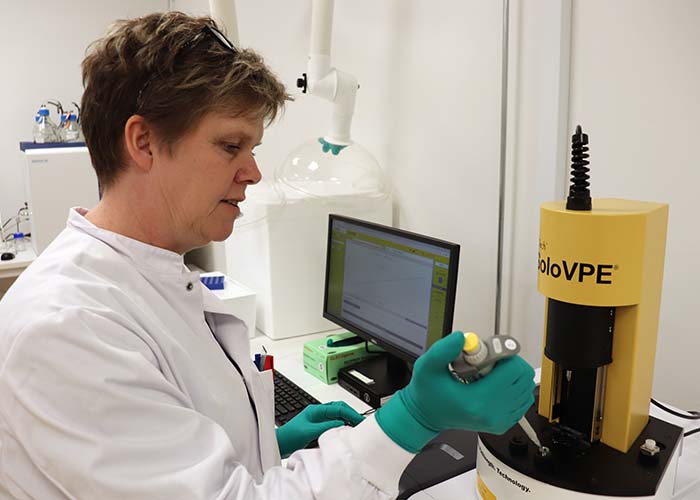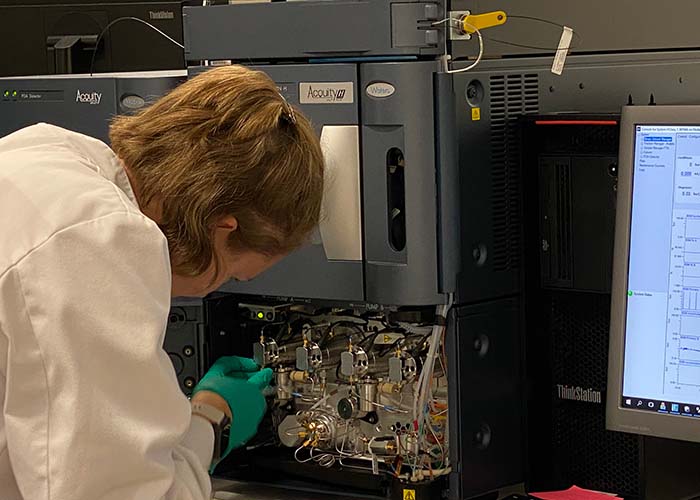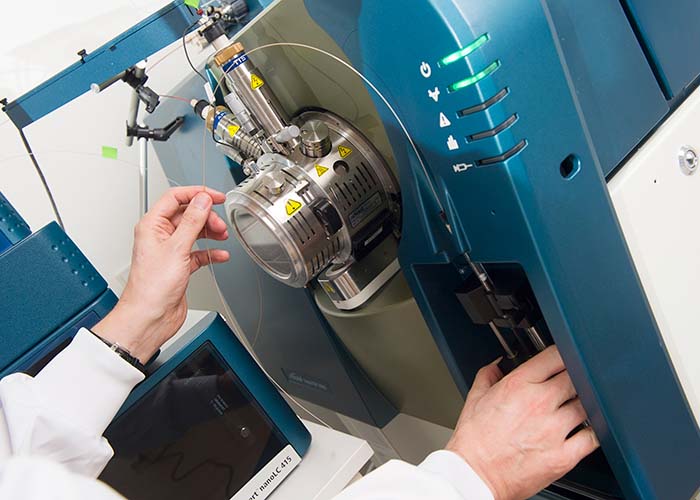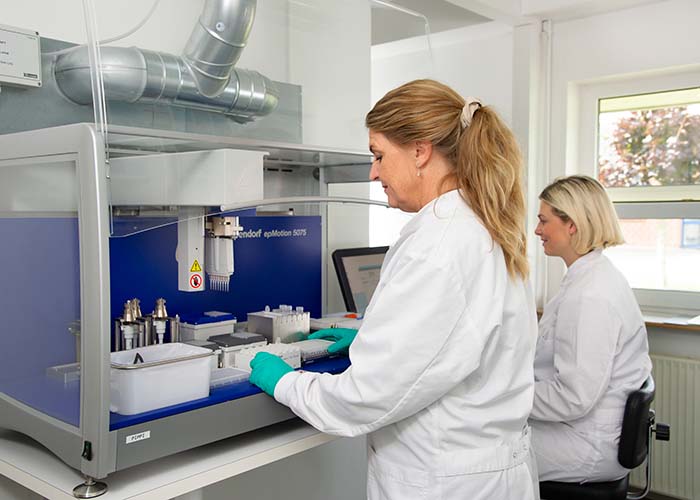Instrumentation and methods
Our high-quality services utilize the best instrumentation on the market with optimized setups for each machine. Below is a list of our methods and a short description of each.
Amino Acid Analysis
The protein/peptide mixture or purified protein/peptide sample is subject to hydrolysis, thus creating free amino acids. IEX-HPLC then analyzes these with post-column ninhydrin derivatization. The method accurately identifies and quantifies up to 20 amino acids and calculates the total protein content from the summed amino acid amounts.
Differences in ninhydrin reactivity and hydrolysis efficiency for every run occur. Therefore an analysis standard (NIST BSA) is prepared in duplicate with the sample. Using the NIST BSA, we calculate a compensation factor to determine the amount of individual free amino acids in the sample. We also run NIST BSA controls after every six samples to monitor the ninhydrin activity's precision and accuracy.
Furthermore, we use an amino acid standard mixture to calibrate the instrument according to the maintenance plan.

Extinction Coefficient
First, we determine the exact quantity of protein/antibody by our amino acid analysis service. Then we determine the mass extinction coefficient at UV absorbance 280 nm (other wavelengths are also possible) with the SoloVPE®. Finally, we calculate the molar extinction coefficient from the molecular weight of the protein.

ELISA-MS™
The immunological, plate-based Enzyme-Linked Immunosorbent Assay (ELISA) measures and quantifies molecules, such as antibodies, peptides, and proteins.
In a 'sandwich ELISA,' the 96-well microtiter plate is coated with a capture antibody that binds the sample antigen (e.g., protein). Hereafter, a detecting antibody binds to the antigen. A secondary antibody binds and cleaves an added substrate through its linked enzyme, thus leading to a detectable signal. The signal depends on the antigen amount.
ELISA-MS™️ combines immunocapture using anti-HCP antibodies and LC-MS instead of a detection antibody. This enables the identification of HCPs covered by the ELISA antibodies and those not covered.

HPLC/Chromatography
High-Performance Liquid Chromatography (HPLC analysis)
Form of column chromatography, where the sample solution in solvent (mobile phase) pumps through the column (stationary phase) at high pressure. The technique separates and identifies molecules based on their chemical properties. You will often use a UV or fluorescent detector in cases without an HPLC coupled to the mass spectrometer.
Reversed-Phase (RP-HPLC)
This is the most commonly used HPLC type with a non-polar stationary phase and an aqueous, polar mobile phase. In RP-HPLC, hydrophobic molecules interact with the stationary phase, whereas hydrophilic molecules elute first.
Size Exclusion (SEC-HPLC)
Type of HPLC that separates molecules based on their molecular size. The column is packed with delicate, porous beads separates small and big molecules since the smaller molecules can enter the pores. Thus, they move slower than larger molecules that cannot interact and enter the pores.
Ion Exchange (IEX-HPLC)
Type of HPLC that separates ionizable molecules based on their net charge. After loading the protein sample on the column, a washing step removes impurities before proteins elute from the column with a change in pH or a salt gradient.
Hydrophilic Interaction Liquid Chromatography (HILIC)
HILIC is an alternative HPLC mode with a polar stationary phase and an aqueous mobile phase, often as a gradient from a high percentage of organic solvent to a high ratio of the aqueous solvent. HILIC is especially useful for separating polar compounds, such as glycosylated proteins and released glycans.

ESI-MS
Electrospray Ionization (ESI)
The ionization technique transforms ions of proteins and peptides from a liquid solution to a gaseous state before mass spectrometric detection. ESI Mass Spectrometry (ESI-MS) has high sensitivity and robustness, thus making it well-suited for non-volatile molecules and complex sample solutions.
Liquid Chromatography Mass Spectrometry (LC-MS and LC-MS/MS)
An HPLC separates the peptides and proteins (in liquid solution) according to chemical properties like hydrophobicity, size, and charge. The components are released from the stationary phase into the mobile phase and subsequently detected and analyzed in the mass spectrometer (MS). If the mixture is subject to tandem mass spectrometry (MS/MS), the first MS selects precursor ions by their mass (m/z), fragments them, and then detects them as product ions in the second MS.
Combining LC-MS with UV detection is also possible, thereby achieving UV trace chromatogram, MS ion current chromatogram, and MS spectra. This method is known as UV HPLC analysis.
NanoLC-MS/MS
A variant of LC-MS/MS with flow rates in the nanoliter/min range. NanoLC-MS/MS has a very long analysis time due to low flow rates. The system can thus only run smaller sample amounts but has higher sensitivity than the conventional LC-MS/MS setup.
SWATH LC-MS/MS
SWATH mass spectrometry is a data-independent acquisition (DIA) technique for detecting and quantifying all detectable compounds in a complex sample. Our instruments combine DIA with a data-dependent acquisition (DDA or IDA). DDA first identifies proteins in a given sample and builds an ion library, which we use for the quantification process in SWATH mode.
Multiple Reaction Monitoring (MRM LC-MS/MS)
This technique is especially suited for quantifying specific, single proteins of particular interest (HCPs). MRM has high sensitivity and specificity, thus making it perfect for targeted analysis of a set of low-level proteins, even if they are only ppm-level abundant.

Sample Prep Robotics
Automated robotics for multi-step sample handling
Robust and reproducible sample preparation is a critical element in the high-quality analysis of biologics. Therefore, top-of-the-line pipetting robotics are applied together with in-house developed procedures to secure fast and consistent sample preparation.

Talk to us
Whatever protein-related challenge or question you may have, we would love to help. Our experts can help you decide on the best analytical approach for your project by email or online meeting - providing advice without obligation.